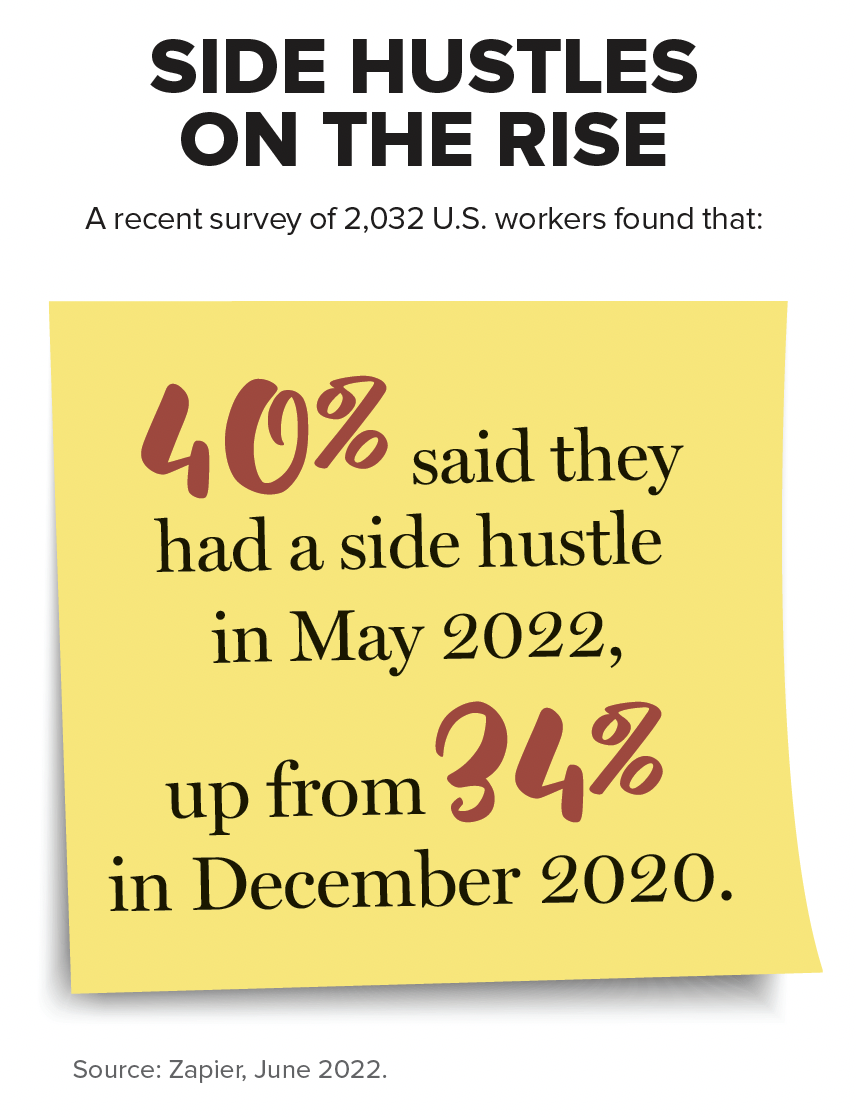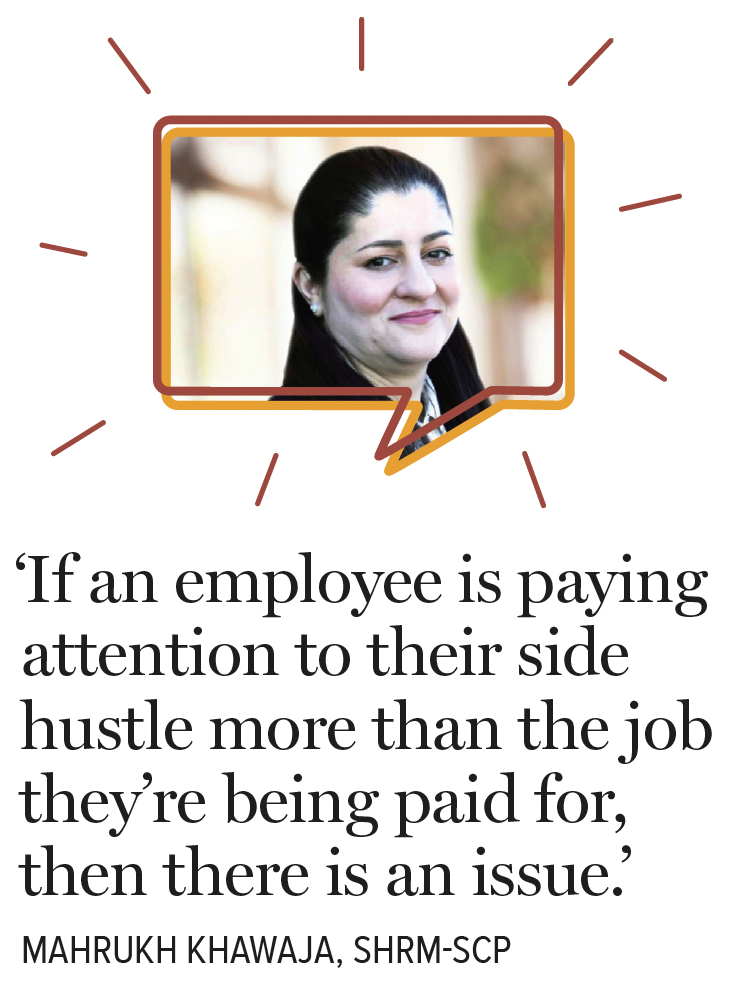
?When an information technology specialist at Enertech began missing deadlines and sleeping at his desk, it was the first time in her lengthy HR career that Jennifer Weber had to put an employee on a performance improvement plan because of a side hustle.
Rather than focusing on his work, the employee was putting all of his energy into making and selling barbecue sauce.
“We got complaints that all he did was talk about his outside job,” says Weber, HR assistant at Enertech, which builds energy-efficient products in Mitchell, S.D. This interfered with the employee’s job duties and disrupted his co-workers.
“In my 20-plus years in HR, I don’t ever remember having to sit down and talk to someone” about a side job, Weber says. She had to tell the employee, “We need you here 100 percent, dedicated to our business 100 percent.”
While Enertech isn’t opposed to employees having side gigs, “it’s important for organizations to care about side hustles because you don’t want the side hustles to interfere with your company’s goals,” Weber says.
Greater Flexibility
The rise of remote work during the pandemic and employees’ ongoing desire to have more-flexible hours may be complicating factors for employers that are concerned about employees paying attention to their side hustles when they should be focusing on their full-time jobs.
“It’s probably more of a problem than it has been in the past,” says Timothy Ford, a partner with law firm Einhorn Barbarito in Denville, N.J. “There’s not as much continuous oversight of an employee as there maybe once was.”
The percentage of employees who report having side hustles has increased in the past 18 months, to 40 percent in May 2022 from 34 percent in December 2020, according to a survey of 2,032 U.S. workers conducted by The Harris Poll on behalf of Zapier, a workflow automation technology provider with a fully remote workforce.
In some cases, it’s not just a side hustle but rather a second job that divides an employee’s attention. An October 2021 survey by ResumeBuilder.com found that 69 percent of 1,250 fully remote U.S. workers had a second job. Perhaps surprisingly, 37 percent had two full-time jobs. The other 32 percent held a part-time position in addition to a full-time gig.
For those with two full-time jobs, 45 percent were working their second job remotely and 23 percent were working a hybrid schedule. Some people take on a side job for enjoyment, but half do so out of financial necessity.
“Company loyalty and dedication are important, but so is earning a living,” says Kate Walker, SHRM-SCP, who left full-time employment in 2021 to start her own executive coaching business.
Employees may need to work multiple jobs to make ends meet due to steep inflation and high gasoline prices, she says, or to cope with an unexpected financial setback, such as a divorce.
Remote and hybrid work schedules have eliminated or reduced commuting times, which can create more flexibility for people to dedicate extra time to other paid pursuits, Walker says.
And as employees have become more accustomed to working remotely, they’ve been able to get work done more efficiently, which allows them to increase the quantity of work they produce, she says.
Walker started establishing her coaching business while holding down a full-time job, taking evenings and weekends to set up the venture.
“I knew I had to depart my corporate job before doing any marketing,” she says.
She launched her business for myriad reasons, including the ability to have more-flexible hours, to work from home all the time, to pick and choose her projects and clients, and to earn more money.
“The ego wants us to stay safe and take the path of least resistance,” Walker says, “so pursuing something new takes a great deal of planning, courage and mindset work.”
The Wall Street Journal reported in August 2021 that some white-collar workers are juggling two full-time remote jobs on the sly. They find encouragement through the website Overemployed, which advises remote workers on how to manage multiple jobs.
Stacie Haller, a career coach, says the people she knows who work two full-time jobs aren’t putting in 80 hours a week. She suspects that those who do probably are low-wage earners or facing financial difficulties.
If someone is working two lower-earning jobs in fields such as retail or hospitality, managers shouldn’t try to dissuade this, as long as it doesn’t interfere with the individual’s work performance, Haller advises.
That’s particularly true right now, she says, when organizations are concerned about retaining talent.
If a remote employee sets up two computers at home and works for two different companies simultaneously, that can violate the terms of their employment, Ford says, but it could also be difficult for a company to detect.
Some employees who work from home “can be doing anything on any given day at any given time,” says Brooke Colaizzi, an attorney with law firm Sherman & Howard in Denver. As a result, it’s important to set strong expectations about job performance and hold employees accountable for meeting them, Colaizzi says.
Pros and Cons
Contrary to what some might think, employees can feel empowered and energized from their side hustles, a recent study found.
By being in charge of their own side jobs, such as driving for Uber or selling merchandise on Etsy, people can be “microentrepreneurs without risk,” working when they want, where they want and how they want, says Hudson Sessions, an assistant professor of management at the University of Oregon and lead author of the study published in the Academy of Management Journal.
A side hustle can provide an employee with fresh routines and help them build new skills, Sessions says, and the sense of empowerment that comes from working a side hustle often generates “good feelings that tend to flow and spill over” into their full-time jobs. It also can enhance their workplace productivity.
Rather than setting strict policies regarding side gigs, “companies would do well to back off and let employees self-regulate,” Sessions recommends.
However, the research also showed that those with enjoyable, meaningful side hustles “tend to be a bit more distracted in their full-time jobs,” Sessions says. As a result, their performance may slip slightly.
“They have a little bit less of themselves available for their full-time job,” he adds. —S.L.
Performance Matters
There’s no guarantee that an employee who works onsite will put more effort into their primary job than their side hustle.
At Enertech, the company received complaints that the IT employee with the barbecue sauce business spent his work hours promoting his product and networking on social media—and even stopping workers on the company’s production line so he could chat about his business, Weber says.
The company’s employee handbook says workers are expected to give 100 percent of their effort to the job, and if management thinks outside employment is interfering with an employee’s ability to do that, the employee will be asked to resign from Enertech or halt their outside employment.
“We never want to deny anybody the chance to have their own business,” Weber says.
The IT employee’s manager collected information on the deadlines the employee had missed and the work he had failed to complete before sitting him down for a talk. The company gave the employee more duties to help keep him busy during the workday and said it was fine if he talked about his business during break times, but not all day long.
There haven’t been any recent complaints from co-workers, Weber says.
Mahrukh Khawaja, SHRM-SCP, HR director at Diversified Brokerage Services Inc. in Minneapolis, dealt with a similar situation when a marketing specialist at the company started a business making dog collars. The employee began missing deadlines and failing to complete her work.
Her manager checked the employee’s Internet history and found she was working on her side hustle and spending time on dog-related websites rather than attending to her full-time job, according to Khawaja. “We had the evidence,” she says. “She was selling dog collars all day. In this day and age, anyone can check what you’re doing.”
The employee was fired and applied for unemployment benefits, but her request was denied. After initially contesting the decision, the worker decided before the next hearing not to pursue the issue, Khawaja says.
She explains it’s important to have a policy in a company’s employee handbook stating that side hustles can’t interfere or conflict with the worker’s main job.
“I think it all comes down to performance,” she says. “If an employee is paying attention to their side hustle more than the job they’re being paid for, then there is an issue.”
At Diversified Brokerage Services, a lot of employees have side hustles, Khawaja says, including the company’s marketing director, who grows and sells vegetables, and another employee who is a beekeeper and sells honey. As long as their performance is not affected, Khawaja says, all is well and good.

Create a Policy?
Paycor, an HR software company based in Cincinnati, has adopted a minimalist approach to regulating employees who take on side jobs.
“I don’t think trying to control it, trying to put stringent rules around it, necessarily works,” says Nathan Peirson, Paycor’s senior vice president of talent and employee experience.
Instead, the company, which has about 2,200 employees, aims to “treat people like adults,” Peirson says. “We trust them.”
Rather than having a policy specifically addressing side hustles and moonlighting, Paycor has a conflict-of-interest policy stipulating that an employee can’t take a second job that “directly competes” with their responsibilities at Paycor, he explains.
As an example, the company would be concerned about an employee who works in Salesforce training and also provides sales training consulting on the side. “We would have a discussion about it,” he says.
Though the company tends to be relaxed about people having side gigs, if someone had two full-time jobs, “that would be problematic,” Peirson says.
“Could it happen? Yeah,” he admits, because when employees work remotely, there’s more flexibility and less visibility. Post-pandemic, “work lives and personal lives are all merged together,” he says.
Still, if employees are distracted by side hustles, “it’s going to show up somewhere,” Peirson says, noting that Paycor measures worker performance based on outcomes.
For certain jobs in certain industries, working for a competitor isn’t necessarily an issue. Ford says it’s not uncommon for nurses and other health care employees to work full time and then have another full-time or part-time nursing job on the side.
In those cases, “you probably don’t need a policy for all employees, just ones at certain levels,” Ford says.

Chad Sorenson, SHRM-SCP, president of Adaptive HR Solutions in Jacksonville, Fla., recommends that most organizations have a policy at least addressing which organizations their employees can’t work for, such as competitors, and specifying that side hustles can’t interfere with their primary job.
However, Sorenson cautions, “the more rigid you get, the more people keep [their side gigs] under wraps.”
An organization may want to make clear that employees should avoid scheduling conflicts between their primary and second jobs and that the second job shouldn’t affect the employee’s performance, he says.
If someone is trying to juggle two jobs and is always tired at work as a result, “all of a sudden there are job performance and work performance issues,” Sorenson says.
Working a side gig “can certainly divide employees’ attention and divide employees’ time,” so it’s important to lay out expectations, says Colaizzi, who advises that organizations explain their policies in writing.
Generally, handbooks have gotten too long and too unwieldy, she says. Instead, she recommends having a stand-alone policy, easily accessible online, that employees can acknowledge and sign when they’re hired.
A Way Out?
In some cases, taking on a side hustle may be a way for people to “inch their way out of the organization,” says Chad Sorenson, SHRM-SCP, president of Adaptive HR Solutions in Jacksonville, Fla. “People are looking for the next thing. They could be testing the waters.”
That’s what happened with Sana’ Walker, SHRM-CP, who, after a decade working for other organizations, now owns and operates the website HR Girlfriends and offers HR consulting and training services.
She took over the site in 2013 while working a full-time job. The side gig was “a passion project,” Walker says. But she knew it could be more, so she spent her days focused on her full-time job and her nights and weekends developing the site, which provides support to women in HR looking to grow personally and professionally.
In 2020, she “took a leap off the W-2 road,” quitting her full-time job to focus solely on the site.
“It seems very sexy to be your own boss, until you are your own boss,” says Walker, who charges people to become members of the site and also supports the venture with money earned from her training and consulting work.
But she has no regrets.
For others in HR who are thinking of parlaying a side gig into a full-time business, Walker’s first recommendation is to create a business plan.
“It helps you think of all the components required to be successful in business,”
she says. —S.L.
Go With It
By day, Paige Hackathorn works as a recruiter for Natural Grocers, a Lakewood, Colo.-based chain. By night and on weekends, she photographs bands performing on the local music scene. She began snapping photos on her cellphone for fun. As her skills improved, she upgraded her photo gear and now gets paid for her side gig.
“I love having this as an outlet,” Hackathorn says of her photography gig, though she notes, “I don’t do anything that would interfere with my day job.”
Natural Grocers has 100 locations and about 5,000 employees. While it has a policy that restricts employees from working at comparable natural grocery stores and employees also must adhere to a confidentiality agreement (Natural Grocers makes its own trail mix and roasts its own coffee beans, for example), Hackathorn says the company doesn’t discourage employees from having side hustles.
Some employers not only tolerate but also support employees’ side gigs. Chicago-based software platform ActiveCampaign, for example, encourages its 1,000 employees worldwide to use the company’s platform for personal and professional ventures—whether that’s to grow a side business or work on a personal project, such as planning a wedding. The company benefits from employee feedback about the platform.
“HR teams must recognize that there is a real business benefit in supporting employees’ passion projects and side hustles,” says Michael Rico, the company’s chief people officer.
Finch Grace, who is a product marketing manager at ActiveCampaign, uses the platform to help sell her nail polish line. Grace started the business in her spare time about nine years ago when she worked for another company. She calls ActiveCampaign’s attitude “refreshing.”
The company has an employee agreement in place that requires workers to protect the company’s proprietary information and also sets employee expectations about work performance and output, Rico says.
“Trust is our No. 1 value,” he notes, and employees are expected to attend to their side gigs after hours.
So far, there haven’t been any concerns with “folks double-dipping or neglecting their core ActiveCampaign activities,” Rico says. “We want people to thrive in both their work lives and their personal lives.”
Susan Ladika is a freelance writer based in Tampa, Fla.

